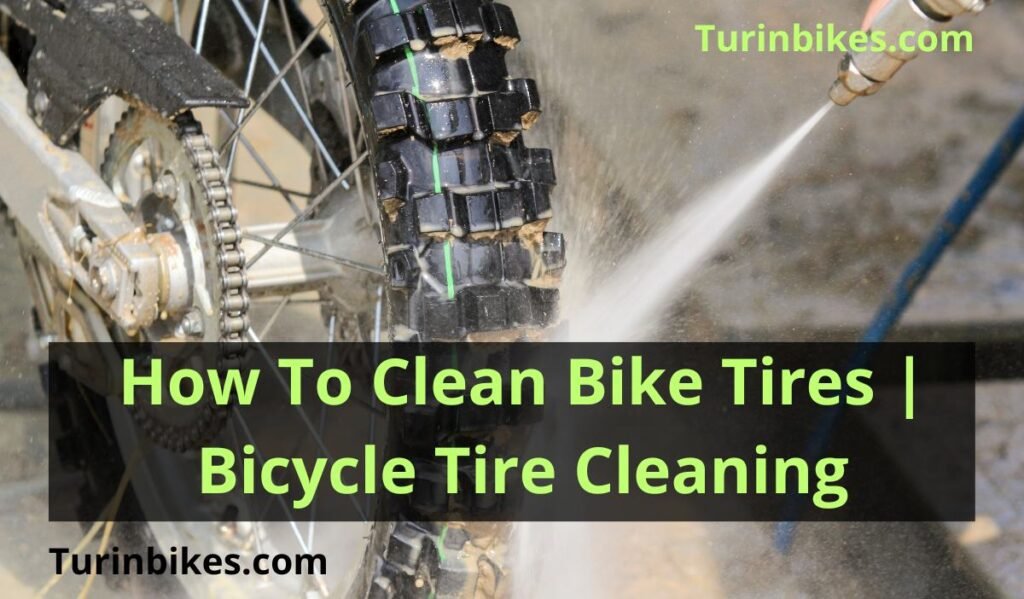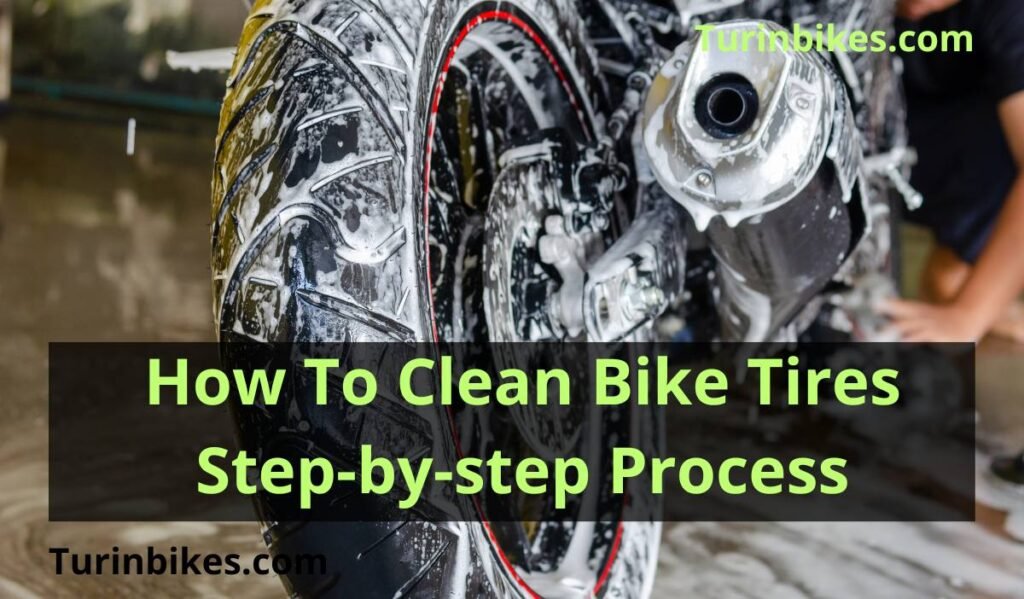
Is your mountain bike looking a little grimy? Do the tires seem to attract every speck of dirt they pass? Don’t despair! Cleaning your bicycle tires can refresh your ride and improve performance. While it may seem daunting, a few simple steps are all you need to get your tires looking clean again. From bunny-hopping through mud puddles to coasting along dusty trails, dirt and debris can quickly build up on your tires and compromise traction and control. Join me as I walk through the process of cleaning tires on your road, mountain, or hybrid bike. You’ll learn handy techniques for removing embedded debris, removing oily residue, and making those tires shine again! With the right way and a little elbow grease, you can wave goodbye to dirty tires. Let’s roll up our sleeves and dive into the simple secrets of how to clean bike tires.

Do Mountain Bike Tires And Road Bike Tires Require The Same Cleaning Process?
There are some differences in cleaning mountain bike tires versus road bike tires:
- Mountain bike tires typically need more intensive cleaning since they pick up heavier dirt, mud, and debris on off-road trails. Road bike tires mainly require the removal of dust, grease, and street grime.
- The deep tread grooves on mountain bike tires require scrubbing with narrow bristle brushes to dislodge compacted mud fully. Road bike tires have shallow tread that is easier to clean.
- Mountain bikers may need to remove the wheels completely to vigorously clean all sides. Quick-release wheels on road bikes allow for easier cleaning access.
- Power washing and pressure washing is commonly used for mountain bike tires to blast off caked-on mud. Road bikes use gentler cleaning methods.
- Mountain bike tire casings flex more, so brush scrubbing requires more care to avoid damage. Stiff road bike tires can handle slightly rougher cleaning.
- Chemical degreasers are often used to cut through thick buildup on mountain bike tires. Road bikes may just need mild soap and water.
While the principles are the same, mountain bikers need to devote extra attention to deep-cleaning knobby, mud-crusted tires. Road cyclists can clean their tires more quickly with light scrubbing. But both types require inspection and maintenance for optimal safety.
List of required equipment you need for cleaning
- Bucket or hose for water
- Mild degreasing detergent
- Stiff bristle brush
- Old rags or sponges
- Air compressor or bike pump
- Lubricant or tire shine
- Clean, dry cloth or towel
Make sure you have all the necessary equipment ready before start the cleaning process. Having everything you need close at hand will make the job quicker and easier.
B. Consider safety gear
While cleaning tires may seem straightforward, take precautions to protect yourself. Wear thick rubber gloves to keep cleaning chemicals off your skin. Eye protection like goggles can shield against debris or tire shine. Close-toed shoes are also recommended when using a pressure washer.
Take safety seriously and gear up properly for the conditions. Your eyes, hands, feet and clothing will thank you later after they haven’t been blasted by dirty tire water!
Preparations For clean bike
A. Choose a suitable location
Pick a spot for cleaning your bicycle tires that has good drainage and ventilation. Avoid areas where the dirty water can pool or runoff into gardens/grass. A driveway, patio or garage are good options for cleaning the tires on your mountain bike (mtb) or road bike.
B. Place the bike on a stand or secure it
Put your mountain bike (mtb) or road bike onto a bike repair stand, or securely lean it against a wall or fence. This allows you to access both sides of the tires and rotate the wheels during the cleaning process. Make sure the bicycle is stable and cannot fall over.
C. Ensure proper ventilation
When using degreasers and cleaners to clean the tires, you’ll want air circulation to prevent buildup of fumes. Open any garage doors or windows in the area. Set up a fan to blow air away as you work on cleaning the bicycle tires. Proper ventilation makes tire cleaning safe and pleasant.
Following these preparatory steps allows you to scrub the bicycle tires efficiently. With your cleaning supplies and bike ready to go, you’ll be able to dive into removing grime and restoring shine to those dirty tires!

How To Clean Bike Tires Step-by-step Process
A. Remove the bike wheel (if necessary)
- Release brakes or quick-release levers on your cycle to remove the rim and access the tire.
- Detach the wheel completely from the bicycle frame.
B. Brush off loose dirt and debris
- Use a soft brush or a cloth to wipe off any large chunks of mud or dirt stuck to the bike tyre.
C. Rinse the tire
- Use a hose or a bucket of soapy water to rinse away surface dirt on the wheel.
- This initial rinse helps clear grit and grime before scrubbing.
D. Apply a cleaning solution
- Use a bike-specific tire cleaner or mild detergent to help lift oil and grease from the bike tyre during cleaning.
- You must Avoid harsh chemicals or solvents that can damage the tire.
E. Scrub the tire
- Use a tire brush or a soft scrubbing pad to rigorously clean the entire exterior surface of the tyre, including the sidewalls.
- This agitation helps loosen embedded debris.
F. Pay attention to the tire treads
- Use a narrow brush or an old toothbrush to get into the tire grooves and remove compacted dirt and grime.
G. Rinse off the cleaning solution
- Use clean water to thoroughly rinse the wheel and wash away all soap residue.
H. Dry the tire
- You need to clean with, dry cloth or towel to wipe down the tyre after rinsing.
I. Reattach the wheel
- Ensure the bicycle rim is securely fastened back onto the frame.
J. Lubricate the tire sidewalls (optional)
- Apply a tire shine product to maintain the clean appearance as part of your bike tyre maintenance and care.
After Clean Your Bike Tires Do Inspection
A. Check for any visible tire damage
After thoroughly cleaning the bike tires, inspect them closely for any issues. Look for cuts, punctures or excessive wear. It’s a good idea to do this inspection each time you clean your bike and tires.
B. Look for cuts, punctures, or excessive wear
Examine the tread and sidewalls of the tires for any embedded glass, nails or debris that could cause a flat. Also check for cracks, dry rot, bald spots or uneven wear, which are signs the tire may need replacement.
C. Assess tire pressure and adjust as needed
Use a bicycle tire pressure gauge to check if the tires are inflated to the PSI recommended by the manufacturer. Under-inflated tires can lead to flat spots. Over-inflated tires may burst. Adjusting the pressure as part of your bike cleaning helps ensure good performance.
Regularly inspecting and maintaining your tires after cleaning your bike helps prevent damage and extends their lifespan. Take time to closely examine each area of the tire to keep your rides rolling smoothly.
Tips and Precautions
Here are some tips and precautions to include when cleaning bike tires:
A. Avoid using harsh chemicals or wrong cleaning products
Stick to mild detergents and bike-specific cleaners to prevent damage to the tire material or tread. Harsh solvents can degrade rubber over time.
B. Always follow the manufacturer’s recommendations
Check your bike and tire owner’s manuals for any special care instructions. Using incompatible cleaners voids the warranty in some cases.
C. Keep cleaning products away from brake components
Prevent chemical contamination of brake rotors, calipers and pads by directing spray and overspray away from these sensitive parts.
D. Be gentle to prevent damage
Use only soft bristle brushes and moderate scrubbing pressure to avoid tearing the tire or puncturing the inner tube.
E. Dispose of cleaning products properly
Follow local regulations and avoid pouring used bike cleaning chemicals down storm drains where they can pollute waterways.
F. Letting tires dry incorrectly can cause issues
After washing, thoroughly dry the entire tire with a clean rag to prevent water spots. Allow sufficient time for inner-liners to dry before reinstalling wheels. Residual moisture inside tires can cause tubular gluing problems down the road.
Taking appropriate precautions keeps your bike, tires and environment safe while cleaning. Handle these sensitive components with care for best results.
Conclusion
Whether mountain biking through muddy trails or zipping across city streets, bike tires quickly accumulate dirt and debris. But regularly taking the time to clean your tires is a crucial part of bicycle maintenance. Washing away embedded grime improves traction and braking control while restoring your tires’ appearance. Implementing a few simple cleaning steps allows you to remove oily residues and prevent premature wear. Just be sure to use proper techniques and mild cleaners to avoid damaging your tires. Ultimately, keeping your bike tires free of grime not only makes your ride look great but also enhances performance and safety. So don’t neglect your tires – get into the habit of periodic cleaning as an essential component of bike care. Your next ride will feel smoother and you’ll have the peace of mind that comes with well-maintained tires.
Why should I clean my bike tires?
To enhance traction, extend tire lifespan, and improve overall bike performance.
How often should I clean my bike tires?
After dirty/wet rides and monthly for routine road cycling.
What do I need to clean my bike tires?
Soft brush, soapy water, tire cleaner, tire brush, old toothbrush, cloth, optional stand, gloves, and eye protection.
How do I protect my bike tires after cleaning them?
Apply a bike-specific tire shine or protectant for a polished appearance.
Can I use any cleaning solution to clean my bike tires?
Use bike-specific tire cleaner or mild detergent, avoiding harsh chemicals.
Do I need to remove the bike wheel to clean the tires?
It’s not necessary but can facilitate thorough cleaning.
Can I use a pressure washer for clean bike tires?
Avoid pressure washers; use a gentle hose or soapy water bucket.
Can I apply tire shine or protectant after cleaning my bike tires?
Yes, use a bike-specific product for a glossy finish.
Should I check my tire pressure after cleaning the tires?
Yes, ensure proper pressure for optimal performance.
How can I protect my bike tires from damage while riding?
Maintain proper pressure, avoid rough terrain, inspect for cuts, and rotate tires regularly for even wear.
Meet Sachin Kumar, an avid cyclist and bike enthusiast with a passion for two-wheeled adventures. At our Turinbikes site, Sachin shares expert insights, thrilling ride experiences, and tips for fellow bike lovers.






